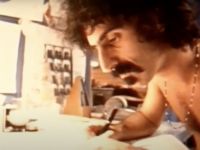A new 5-CD set will focus on Frank Zappa’s pre-Mothers of Invention era, with many tracks making their debut on compact disc. Paul Buff Presents Highlights From The Pal And Original Sound Studio Archives is due on May 28, 2012 from Crossfire Publications.
This 156-track collection features 58 early masters by the late Frank Zappa, recorded at Pal and Original Sound Recording Studios. These recordings feature Zappa as performer, writer and/or producer. Buff, owner of Pal Recording Studio in Cucamonga, California from 1957-1964, first opened up his archives in 2010 for a large series of download-only releases.
Paul Buff Presents Highlights From The Pal And Original Sound Studio Archives will be available in DVD-sized packaging, with a 40-page, illustrated color booklet containing detailed information about the artists and the recordings. The five CDs in the set feature reproductions of the Pal, Plaza, Yukon, Emmy and Vigah! labels.
Pal functioned as the recording home for Buff’s record labels (Pal, Emmy, Yukon, Plaza and Vigah!) and for The Pal Studio Band, a group of musicians revolving around Paul Buff, guitarist Dave Aerni and young guitarist/drummer Frank Zappa. Buff taught Zappa the art of recording studio operation as The Pal Studio Band created a large body of work. On many occasions, this group succeeded in licensing their tracks to larger record labels. When these recordings could not find a home, in-house labels by Buff or Dave Aerni (Daytone, Ador, Daani) released them.
Emmy’s releases featured three singles by The Masters, cut by Buff and guitarist Ronnie Williams. The B-side of the second Masters single, “Breaktime,” featured overdubbed guitar leads by Zappa. Other early singles that spotlighted Frank Zappa were by The Penguins, The Hollywood Persuaders, The Tornadoes, Buddy And The Crickets, Ron Roman, Baby Ray And The Ferns, Brian Lord And The Midnighters, Mr. Clean, The Heartbreakers, Ned & Nelda, Bob Guy, Conrad And The Hurricane Strings, The Cordells, The Rhythm Surfers, The Woody Waggers, The Decades, and Johnny Barakat And The Vestells. Many Pal Studio Band tracks with Zappa involvement make their CD debuts in this box set, including some with original Mothers Of Invention vocalist Ray Collins.
Buff created Pal Recording Studio in December 1957 with a simple two-track Viking recorder. The demand for stereo recording led Buff to create a homemade, five-track recording studio when the industry standard was still mono or two-track stereo recording.
While still at Pal, Buff started working with Art Laboe, owner of Original Sound Records. Laboe asked Buff to create a new recording studio for Original Sound artists, and in 1964, Paul finished creating his own ten-track recording gear. Buff was already in place as Original Sound’s studio engineer when he sold Pal Recording Studio to Frank Zappa on August 1, 1964. Many Original Sound artists were engineered by Buff, who had started making his own recordings at the studio the previous year.
The Surfaris recorded “Wipe Out” at Pal in late 1962; this surf standard is the best known Pal recording. Nearly the entire output of the All-American label (known for Strawberry Alarm Clock’s “Incense And Peppermints”) was engineered by Buff, as was Sugarloaf’s “Green-Eyed Lady” for Liberty.
The first 200 pre-release orders from Crossfire Publications for Paul Buff Presents Highlights From The Pal And Original Sound Studio Archives will be accompanied by two additional CDs – The Tornadoes’ “Now And Then” and “Charge Of The Tornadoes” – featuring an additional 11 tracks that Frank Zappa engineered at Pal during 1962-1963.
The drawing on the front cover of Crossfire’s set is Frank Zappa’s “A Day At The Beach,” which Frank created in the early 1960s for his sister Patrice “Candy” Zappa. This set joins the book reissues of Candy Zappa’s “My Brother Was A Mother: Take 2” and father Frank V. Zappa’s “Chances: And How To Take Them.”
[amazon_enhanced asin=”B003JFHF5G” container=”” container_class=”” price=”All” background_color=”FFFFFF” link_color=”000000″ text_color=”0000FF” /] [amazon_enhanced asin=”B0000009VS” container=”” container_class=”” price=”All” background_color=”FFFFFF” link_color=”000000″ text_color=”0000FF” /] [amazon_enhanced asin=”B003JFFVFC” container=”” container_class=”” price=”All” background_color=”FFFFFF” link_color=”000000″ text_color=”0000FF” /] [amazon_enhanced asin=”B0000009TN” container=”” container_class=”” price=”All” background_color=”FFFFFF” link_color=”000000″ text_color=”0000FF” /] [amazon_enhanced asin=”B003V3V0S4″ container=”” container_class=”” price=”All” background_color=”FFFFFF” link_color=”000000″ text_color=”0000FF” /]
Here’s a look back at our recent thoughts on Frank Zappa. Click through the titles for complete reviews …
FRANK ZAPPA – THE TORTURE NEVER STOPS (2008): What better way to spend Halloween than with (as it’s lovingly referred to in the liner notes) “this thing”? “The Torture Never Stops” — a 24-song, two-hour blast of almost indescribably brilliant/crazy rock from an Oct. 31, 1981 concert by the equally brilliant/crazy Frank Zappa — affords us a unique opportunity to experience one of popular music’s most original guitarists, composers and personalities. Just as fitting, the mood is absolutely right for a late October night: Zappa and Co. are literally emersed in a creepy, crimson light.
FRANK ZAPPA – TRANCE-FUSION (2006): Listening to excerpted guitar solos is like viewing abstract art: It’s a glimpse of something that doesn’t necessarily have to make sense in the general definition of the term. Were we talking about most guitarists, an album of extracted solos would likely be a pretty dreadful proposition, but when it comes to Frank Zappa on Trance-Fusion, it truly is art — and it’s truly abstract. Few guitarists possess the skill or prowess to make their solos for the same songs sound entirely different from performance to performance, but that’s just what Zappa set out to do.
ONE TRACK MIND: FRANK ZAPPA, “WILLIE THE PIMP” (1969): The whole record was instrumental…well, almost. For the second cut “Willie The Pimp,” Zappa brought in childhood friend Don Vliet aka Captain Beefheart to lend his trademark Howlin’ Wolf growl to some brief lyrics about a “a little pimp with my hair gassed back” while Sugarcane Harris’ violin supplies the song’s riff—actually the riff is the song. So, why am I pimping it? Because of Zappa’s guitar work, that’s why! As Vliet is winding down his little bit with hoops and hollers, ZP’s heavily phased axe comes into focus and for the first time, most of the world finds out that not only can the man compose, arrange and record, but he’s a mighty fine guitar player to boot. We’re not talking one of these succinct, thirty-second solo’s either; Zappa starts his flight at around 1:15 mark and goes all the way to the song’s end more than eight minutes later.




